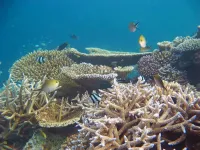(Press-News.org) Malaria still kills millions. Researchers are excited by a new intervention: giving people a drug which kills mosquitoes that bite them. Incredibly, this is a reality, as the drug ivermectin, widely used for the control of parasite infections such as lymphatic filariasis and onchocerciasis, appears to do this. With some mosquitoes now resistant to the insecticides used in treated bed nets, this is a potentially important new control measure.
LSTM's Dr Rebecca Thomas and Dr Joseph Okebe, together with Dr de Souza from the Noguchi Memorial Institute for Medical Research (NMIMR(link is external)), University of Ghana, first examined the experimental evidence that giving the drug to people kills the mosquitoes that bite them.
All included studies showed large effects of ivermectin on mosquito mortality. They then went on to seek studies that evaluated whether this made a difference in malaria transmission and the amount of malaria in people living in malarial areas. They found only one study has been published to date. When published in 2019, there was quite a lot of press coverage stating ivermectin reduced malaria in children based on original report of this trial.
Unfortunately, although this paper was published in the Lancet, the statistical methods used in the analysis were not standard and did not adjust adequately for clustering, so the effect may have been overestimated.
After the researchers who did the original study kindly supplied the data, the London School of Hygiene and Tropical Medicine's Dr Clémence Leyrat, expert in issues of small samples and non-compliance in cluster-randomized trials, and Dr John Bradley, expert in cluster-randomized trials, reanalysed the data and are part of the Cochrane review author team.
Dr Leyrat and Dr Bradley said: "To date there has been one small pilot trial of ivermectin. The statistical analysis of the trial was unsuitable, and the original publication overstated the amount of evidence it provided. With this reanalysis we show that the trial did not produce strong evidence that mass administration of ivermectin is useful in preventing malaria, leaving the question of its efficacy open. Fortunately, there are some larger trials in progress which will provide further evidence."
The one included study enrolled eight villages in Burkina Faso, which were randomly assigned to receive ivermectin or a control. All villages received ivermectin, as part of the scheduled control of lymphatic filariasis. In addition, the treatment villages received five more doses of ivermectin, once every three weeks. The effect of ivermectin on malaria was measured in children younger than five years of age. In these children, the treatment did not show a notable difference in the presence of malaria between the treatment and control groups. Following the review of the data from this study, the team summarized that they were uncertain whether community administration of ivermectin influenced malaria transmission.
Dr de Souza from the NMIMR commented, "There may be varied reasons for the observed lack of evidence. However, challenges to the use of ivermectin could be the duration of the reproductive cycle in mosquitoes, the mosquito behaviour, and the incubation period of malaria parasites in the mosquito. While the conditions for laboratory experiments are carefully controlled, there may be wide variations in the natural environment. As such, a short-term increase in mosquito mortality alone through ivermectin administration could slightly reduce the risk of malaria transmission but may not be sufficient for a sustained impact. Given the ivermectin half-life in the blood, maintaining a high enough ivermectin concentration over several days and weeks to kill any blood feeding, infective, mosquito will be key"
Senior author, Dr Joseph Okebe agreed: "Unfortunately, it is currently not possible to say if treating an entire community with ivermectin reduces malaria. However, several research studies are in progress and, as such, we anticipate they will provide more answers to this important question in the future".
INFORMATION:
de Souza DK, Thomas R, Bradley J, Leyrat C, Boakye DA, Okebe J. Ivermectin treatment in humans for reducing malaria transmission.(link is external) Cochrane Database of Systematic Reviews 2021, Issue 6. Art. No.: CD013117. DOI: 10.1002/14651858.CD013117.pub2
Predicting the potential effects of coral loss on fish communities globally is a fundamental task, especially considering that reef fishes provide protein to millions of people. A new study led by the University of Helsinki predicts how fish diversity will respond to declines in coral diversity and shows that future coral loss might cause a more than 40% reduction in reef fish diversity globally.
Corals increasingly bleach and often die when the water warms. What happens to fish if there are no alternative reefs to swim to? The few fish species that feed on corals will inevitably starve, but the rest might find alternative rocky habitat to persist. As yet, it has been hard to ...
By the beginning of April 2021, the number of people infected during the COVID-19 pandemic had risen to more than 130 million people of whom more than 2.8 million died. The SARS-CoV-2 virus responsible for COVID-19 is transmitted particularly by droplets or aerosols emitted when an infected person speaks, sneezes or coughs. This is how the viruses and other pathogens spread through the environment and transmit infectious diseases when they are inhaled by someone else.
The capacity of these particles to remain suspended in the air and to spread in the environment depends largely on the size and nature of the air flow generated by the expiration of air. As with other airborne infectious diseases such as tuberculosis, common flu ...
Significantly higher rates of child intensive care admissions for unintentional cannabis poisonings have been seen following legalization of the drug in Canada.
Researchers from The Hospital for Sick Children (SickKids), based in Toronto, found a four-fold increase in unintentional poisonings in children under the age of 12 and a three-fold increase in intensive care admissions for severe cannabis poisoning in the first two years following cannabis legalization.
However, the overall number of visits per month for cannabis intoxications to the SickKids Emergency Department (ED) remained consistent when comparing the pre- and post-legalization ...
Researchers at the National Institute of Standards and Technology (NIST) have upgraded their laser frequency-comb instrument to simultaneously measure three airborne greenhouse gases -- nitrous oxide, carbon dioxide and water vapor -- plus the major air pollutants ozone and carbon monoxide.
Combined with an earlier version of the system that measures methane, NIST's dual comb technology can now sense all four primary greenhouse gases, which could help in understanding and monitoring emissions of these heat-trapping gases implicated in climate change. The newest comb system can also help assess urban air quality.
These NIST instruments identify gas signatures by precisely measuring the amounts of light ...
A McGill-led study has shown that the size of the Maya population in the lowland city of Itzan (in present-day Guatemala) varied over time in response to climate change. The findings, published recently in Quaternary Science Reviews, show that both droughts and very wet periods led to important population declines.
These results are based on using a relatively new technique involving looking at stanols (organic molecules found in human and animal faecal matter) taken from the bottom of a nearby lake. Measurements of stanols were used to estimate changes in population size and to examine how they align with information about climate variability and changes in vegetation drawn from other biological and archaeological sources.
By using the technique, the researchers were able ...
Increasing our understanding of cellular processes requires information about the types of biomolecules involved, their locations, and their interactions. This requires the molecules to be labeled without affecting physiological processes (bioorthogonality). This works when the markers are very quickly and selectively coupled using small molecules and "click chemistry". In the journal Angewandte Chemie, a team of researchers has now introduced a novel type of click reaction that is also suitable for living cells and organisms.
As an example, labeling biomolecules allows for the localization and characterization of tumors ...
A new Finnish study shows that 180 health care workers who had received two doses of the Pfizer and Biontech vaccine have very good antibody responses against the SARS-CoV-2 virus. The immune response was as strong against the alpha variant (formerly the UK variant) but was somewhat decreased against the beta variant (formerly the South Africa variant).
Finnish researchers from the University of Turku and University of Helsinki together with Turku University Hospital, Helsinki University Hospital, and the Finnish Institute for Health and Welfare studied the immune response induced by the coronavirus vaccinations, which started in Finland in December. The researchers analysed vaccine responses ...
Growing in popularity, unagi kabayaki - grilled freshwater eel in soy sauce - can be found on the menu of many Japanese restaurants, and is stocked by Asian shops and in specialist supermarkets. But new research tracing the DNA of eel fillets used for this dish has found that fraudulent food labelling is rife, with a third of the products violating EU regulations on the provision of food information. With certain species of eels now endangered, the researchers say that accurate labelling on these products is vital if the global eel trade is to be sustainable.
The European eel is a critically ...
Plants play an essential role in curbing climate change, absorbing about one-third of the carbon dioxide emitted from human activities and storing it in soil so it doesn't become a heat-trapping gas. Extreme weather affects this ecosystem service, but when it comes to understanding carbon uptake, floods are studied far less than droughts - and they may be just as important, according to new research.
In a global analysis of vegetation over more than three decades, Stanford University researchers found that photosynthesis - the process by which plants take up carbon dioxide from the atmosphere - was primarily influenced by floods and heavy rainfall nearly as often as droughts in many locations. The paper, published in Environmental Research Letters on June ...
A key component of next-generation solar panels can be created without expensive, high-temperature fabrication methods, demonstrating a pathway to large scale, low-cost manufacturing for commercial applications.
Nickel oxide (NiO) is used as an inexpensive hole-transport layer in perovskite solar cells because of its favourable optical properties and long-term stability.
Making high-quality NiO films for solar cells usually requires an energy intensive and high-temperature treatment process called thermal annealing, which is not only costly, but also incompatible with plastic substrates, until now precluding the use of ...



